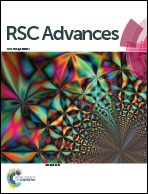Bi-functional reduced graphene oxide/AgCo composite nanosheets: an efficient catalyst and SERS substrate for monitoring the catalytic reactions†
Abstract
The preparation of supported monodispersed bimetallic nanoparticles is important in the fields of catalysis and surface-enhanced Raman scattering (SERS) detection. In this work, a simple in situ co-reduction approach has been demonstrated for the synthesis of AgCo alloy nanoparticles with a size of 20–100 nm supported on the surface of reduced graphene oxide (rGO) nanosheets. The resulting rGO/AgCo composite nanosheets are well characterized using scanning electron microscopy (SEM), transmission electron microscopy (TEM), Fourier transform infrared spectroscopy (FTIR), Raman spectroscopy, X-ray diffraction (XRD), and X-ray photoelectron microscopy (XPS) measurements. The as-prepared rGO/AgCo composite nanosheets show a superior catalytic activity for the reduction of methylene blue (MB) in the presence of NaBH4 and the degradation of MB under ultraviolet light over rGO/Ag, rGO/Co, rGO/Ag3Co1 and rGO/Ag1Co3 composite nanosheets. In addition, the rGO/AgCo composite nanosheets have also been proved to be efficient surface-enhanced Raman scattering (SERS) substrates. The unique two-dimensional structure and strong interactions between rGO and AgCo alloy nanoparticles contribute to the electromagnetic field SERS enhancement. Owing to the excellent catalytic properties and unique SERS sensitivity, a facile approach to monitor and determine the reaction kinetics of the catalytic reduction or photocatalytic degradation of MB using rGO/AgCo composite nanosheets as both catalyst or photocatalyst and SERS substrate has been demonstrated. In addition, the as-prepared rGO/AgCo composite nanosheets have also been used as efficient SERS substrates to monitor the plasmon-driven catalytic reaction of p-nitrothiophenol (PNTP) dimerizing into 4,4′-dimercaptoazobenzene (DMAB). Therefore, it is anticipated that this approach will be used to fabricate many other kinds of supported nanocatalysts, which could be applicable to study more general catalytic reaction processes and provide more information on the catalytic intermediates and final products.



 Please wait while we load your content...
Please wait while we load your content...